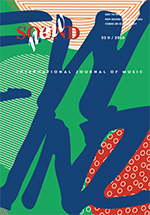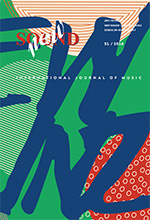Issue No. 47
Composer Speaks
Vesna Mikić – (FOOT)NOTES ON MUSIC.
An Interview with Kornelije Bata Kovač
Download: ser / eng
In Memoriam
Vesna Karin – OLIVERA VASIĆ
(August 18, 1946 – October 28, 2015)
Download: ser / eng
Studies
Bojana Matejić – VERGEBLICHES WARTEN? BADIOU, EVENT, AND HUMAN
EMANCIPATION IN MUSIC
Abstract: The polemic on waiting for human emancipation in music belongs to the modern aesthetic plane, where Adorno’s and Heidegger’s manuscripts occupy a specific place.
However, while Heidegger’s ontology of the waiting implies waiting for the metaphysics
of presence (Will), Adorno maintains that music should rather express “waiting in vain” (vergebliches Warten) by its spatio-temporal structuration, given that “after Auschwitz” philosophy with metaphysical assumptions is no longer possible. In the light of Adorno’s
modern interpretation of waiting in vain, my aim is to examine Badiou’s conception of the
Event-Subject in music. The thesis of this paper is that Adorno’s concept of waiting in
vain expresses defeatism of the known (perseverance-of-self) – which, due to its own
character of filled affect of disappointment, does not leave time-space for newness. On the
trail of Badiou’s ontology of subtraction, I oppose the conception of affirmative, non-eschatological, chiliastic expectation (“surplus of waiting”) to the passive waiting in vain in music.
Keywords: Vergebliches Warten (“waiting in vain”), non-eschatological, chiliastic expectation, Event, Subject of music, Wagner, Adorno, Badiou.
Download: ser / eng
Dragana Stojanović – STRATEGIES OF WORKING WITH THE SONOROUS BODY:
IDENTIFYING OTHER/NEW WRITING TECHNIQUES IN tHE
FIElD OF BODILY SOUND EXPRESSION
Abstract: The issue of the entanglement and interdependence of corporeality and textuality in the process of creating writing attracts attention both in the field of sound and of
semantic and bodily expression in sound. When the body is established in the process of
semanticization (and re-semanticization), as a specific threshold of writing, the place and
role of the sonorous body forms the focus of theoretical research in that discursive space.
This text explores the body’s relational connection with writing, focusing on the always
present transformative potential of speaking writing (again) as a consequence and condition of bodily expression in sound.
Keywords: the body, corporeality, textuality, writing, working with writing aloud.
Download: ser / eng
Mina Božanić – THE MUSICAL SPACE: A SKETCH FOR A BROADER
MUSICOLOGICAL–SEEMIOTICAL DISCUSSION
Abstract: The subject of this paper is an examination of the analytical competences of
musical semiotics and prolongation analysis applied to the organisation of the musical
space in the music of the 20th century. By means of presenting one of the possible ways
of organizing the musical space – the organisation of pitches and registers – one can derive
the synthesis of Eero Tarasti’s semiotics of the musical space and certain segments of
prolongation analysis. Starting from the assumption that the organisation of the musical
space is the key determinant of the music of the 20th century (Masnikosa, 2010: 242), I
will argue that the musical space has its ‘stronghold’ in the works of European high modernism. By confronting Tarasti’s model of the musical space with some segments of prolongation analysis (more precisely, with the theory of harmony by Olli Väisälä and tonal
pitch spaces by Fred Lerdahl, with the addition of the theory of musical forces by Steve
Larson), I will try to show how the organisation of the musical space can be implied in the
analysis of Iannis Xenakis’s (1922–2001) work Metastaseis (1953/4).
Keywords: the musical space, the organisation of the musical space, Tarasti, prolongation
analysis theory, Xenakis.
Download: ser / eng
Nikola Samardžić – THE JAZZ AVANT-GARDE IN THE AMERICAN ECONOMY
Abstract: Jazz originated and evolved in a free market economy and complex mutual
relations with unregulated social conjuncture. Coping with social challenges during the
Progressive era (1890-1920) contributed to the partial emancipation of marginalized
groups; however jazz, in its first decades, remained directed to the general need for mass
entertainment (the “jazz era” in the 1920s). The artistic development of jazz was therefore
temporarily delayed during the economic crisis, Great Depression and the new recession
of the late 1930s (1929-1938). The first movement in jazz that could be considered to be
an art for art’s sake, while renouncing any populist elements, appeared in 1939 Coleman
Hawkins’ Body and Soul recording. Market and social conditions for the emergence of
the avant-garde began to mature only during the years after 1945, within a new business
cycle in the US economy. The prosperous and conformist decade of the 1950s stabilized
the middle class and directed general social preferences towards the benefits of higher
education. European immigration from the inter-war period, and a new wave of immigration at the end of the Second World War enabled the growth of American universities in
terms of quality and social influence. Universities recruited the jazz avant-garde audience,
and supported other progressive art movements in the 1960s “decade of turbulence, protest, and disillusionment”. Thanks to market support, the jazz avant-garde managed to
survive free of the influences of state institutions, as John Coltrane’s Love Supreme, often
listed amongst the greatest jazz albums of all time, was sold in about 500,000 copies by
1970. A similar development, with the emergence of the baby-boom generation in the late
1960s, has contributed to the maturing of European avant-garde audiences and markets
(ECM, 1969). The study will also examine avant-garde movements in relation to historical
changes in economic and social disparities, from the thirties to the early 1970s.
Keywords: jazz avant-garde, economic trends, social differences, market, high education.
Download: ser / eng
Aleksandar Šarović – THE USES AND GRATIFICATIONS THEORY
(IN THE CASE OF HOUSE MUSIC)
Abstract: The paper pays particular attention to teaching of Denis McQuail who considered that people are accessing the mass media with their needs, and focusing themselves
in observing, listening, or reading, by complex of expectations or pursued gratifications.
According to McQuail, the most important gratifications that are provided by media are:
diversion, personal relationships, personal Identity and surveillance.
In the paper we will expose these effects, ie. uses and gratifications that music provides,
in the case of house music. House music fits perfectly in the uses and gratifications theory
which insists on the activity of creators, emitters and the recipients of the messages (the
audience).
Keywords: mass media, human gratifications, the uses and gratifications theory, music,
House music.
Download: ser / eng
New Works
Milena Medić – THE SUMATRAIST SECRET OF COUNT
SAVA VLADISLAVIĆ’S GREAT DREAMING:
THE ANAMORPHOSIC AIM OF THEATRICAL DOUBLING,
THE EX-CENTRED OBSERVER, AND THE REGENERATIVE
POWER OF COLLECTIVE MEMORY
Abstract: In her discussion of Melanholični snovi grofa Save Vladislavića (The Melancholy Dreams of Count Sava Vladislavić), an opera by Serbian composer Svetislav Božić,
the author begins by discussing the composer’s operatic allusion to anamorphosis, an architecture and painting technique, in both of its application modes (the perspectival and
the catoptric). The trans-media and temporal conversion of this visual tool into the aspect
of staged drama is notable in the theatrical procedure of reflective doublings of roles/characters and production of visual syntactic parallelisms, which deepen semantic relations between otherwise unrelated personages and events from various but important layers of Serbian cultural and intellectual history (Nemanjić, Nikola Tesla, Count Sava
Vladislavić). The logic of unclose similarity and borderline contact relates anamorphosis
to a special way of ordering the imagery of dreams, whereby the symbolic interiority of a
hidden image, the mysterious pattern of sense, may be penetrated only by finding the
correct viewing angle. In its longing for the obscure, anamorphosic focalization counts on
the ex-centred spectator’s capacity to approximate the remote and relate the unrelated. In
that sense, shaping the Count’s great dreaming by means of a polyphony of oneiric subjects and states and a heteroglossia of remote contexts and other people’s stories and
lyrical contemplations suggests Sumatraism as a chronotope, as the idea that there is
universal connectedness and harmony in the world. The idea of Sumatraist connections
informs both the understanding of the opera libretto’s inter-textuality (along the lines of
the quotation-collage form of the cento, the literary genre) and the arc of association that
the composer draws in harmonic-motivic terms as well, in order to produce a special
nexus of music-dramatic narration and presentation. In that Sumatraist inter-textual nexus,
other people’s stories and lyrical contemplations, qua manifestations of a collective consciousness, are deepened by means of a collectively unconscious (archetypal) perspective
of a mythical, allegorical, and phantasmagorical dance-pantomime procession, as yet another oneiric form, whose typical Dionysian sequence, intoxicatio-phalophoria-sparagmos, affirms not only the theatrical model of anamorphosic doubling and Sumatraist
connections, but also a unique theme in this operatic narrative – transcending sacrifice,
tribulation, and death in a foreign land by means of the regenerative power of collective
(historical and cultural) memory.
Keywords: Svetislav Božić, opera of oneiric states, anamorphic perspective, Sumatraism,
collective memory.
Download: ser / eng
Research and Tradition
Eudjen Cinc, Jasmina Stolić – ROMANIAN COMPOSERS’ SPIRITUAL CREATIVITY
IN THE 20th CENTURY – MUSICAL HAGIOGRAPHY
OF THE ORDEAL OF A SOCIETY
Abstract: The spiritual music creativity of Romanian composers in the 20th century underwent numerous phases, between their zenith and despair, due to societal events specific
for all of eastern Europe in the past century. Despite the fact that this creativity, in essence,
expresses the tradition of the East, and does not seek to minimize its Byzantine roots,
many composers, especially in the second half of the 20th century, left aside the elements
of these aesthetics and directed their creative focus towards new creative tendencies. This
work reviews the works based on spiritual topics by 20th century Romanian composers,
from the first decades, including the years of Communist government, till the days when
they set out on a postmodern creative course, and it presents the names of the majority of
composers who dedicated their works to the worship of the Almighty, analyzing thoroughly the information found at the Union of Composers and Musicologists of Romania
in Bucharest.
Keywords: spiritual repertoire, vocal music, instrumental music, stages pieces of a
spiritual character.
Download: ser / eng
Reviews
Katrin Stöck
– Jelena novak: Postopera.
Reinventing the Voice-Body, Ashgate 2015
Download: ser / eng
Marija Maglov – Sanela Nikolić: Avangardna umetnost
kao teorijska praksa:
Black Mountain College, Darmštatski
internacionalni letnji kursevi za novu
muziku i Tel Quel
[Avant-garde art as theoretical practice: Black Mountain College, Darmstadt
International Summer Courses for New
Music and Tel Quel]
Belgrade: Faculty of Music, 2015.
(Monographic Series, Tempus Project
inMusWB, VIII),
ISBN 978-86-88619-60-8. 337 pages
Download: ser / eng
Nikola Pejčinović – The 11th festival Koncerti mladih autora – KoMA (Young Authors’ Concerts)
Download: ser / eng
Nikola Pejčinović – The 24th International
Review of Composers
Download: ser / eng
Marija Dumnić – Back to the Future: Popular Music and
Time (18th Biennial IASPM Conference
in Campinas, 2015)
Download: ser / eng
Defended Doctoral Theses
Nataša Dimić – Аспекти великог појања у контексту
српске православне црквене музике
(The Aspects of Great Chant in the
Context of Serbian Orthodox
Church Music)
Download: ser / eng


